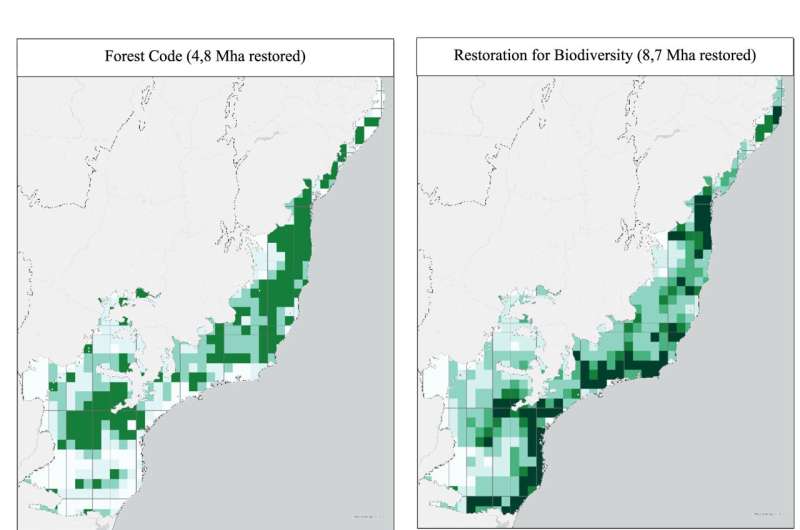This article has been reviewed according to Science X's editorial process and policies. Editors have highlighted the following attributes while ensuring the content's credibility:
fact-checked
peer-reviewed publication
trusted source
proofread
Smallholder farmers, efficient ranching practices critical to meet restoration targets in Brazil's Atlantic Forest

A new study led by King's College London simulated the effects of various restoration policies to assess their impact on biodiversity and agricultural production.
The simulation study highlights that supporting smallholder farmers to restore native vegetation on their land would be necessary to reach the ambitious target of restoring 15 million hectares by 2050—with this group currently exempt under Brazil's Native Vegetation Protection Law, also known as the "Forest Code."
According to the World Wildlife Fund, the Atlantic Forest once covered more than 350 million acres, but human activity has destroyed almost 90% of it, making it one of the most endangered biomes in the world. Much of what forest is left is highly fragmented.
The study, led by Dr. Yara Shennan-Farpón, Postdoctoral Research Associate in the Department of Geography, and published in Environmental Research Letters, compared various restoration policy options and their effects on cropland, pastureland and biodiversity in Brazil, a country whose economy is heavily dependent on agriculture.
She said, "Globally, ambitious targets to restore forests are met with the challenge of an increasing demand for land for food production. Our new study simulates different policies to assess their potential to meet such targets for restoring Brazil's Atlantic Forest, a global biodiversity hotspot which has degraded over the years."
Researchers from the Oxford University Nature-based Solutions Initiative, International Institute for Applied Systems Analysis (IIASA), Austria, and the University of São Paulo, Brazil, were also involved in the work.
Dr. Aline Soterroni, Research Fellow in the Nature-based Solutions Initiative at the University of Oxford, added, "Our study considers ambitious native vegetation restoration targets that go beyond current polices by focusing on biodiversity and support for smallholders.
"We conclude that ambitious restoration targets for the biome, such as the 15 million hectares set by the Atlantic Forest Pact, can be achieved alongside agricultural expansion if mechanisms specifically designed to support smallholders are created."
Their research reinforces that more sustainable and efficient agricultural production—especially in cattle ranching practices—will be required to meet large-scale ecosystem restoration goals.
The team simulated the effects of implementing Brazil's "Forest Code" on the Atlantic Forest biome between 2020 and 2050.
The Forest Code mandates that farms must restore or protect native vegetation to cover 20% of their land in this biome. However, the legislation was amended in 2012 to exempt small landowners from this rule.
Simulating restoration policy options
Using the Forest Code as the baseline scenario, three other restoration policy scenarios were tested: first, simulating restoration on all farms, including small farms (removing the existing exemption); second, imposing restoration targets based on restoring native vegetation within "biodiversity priority areas"; and third, simulating the most ambitious target of restoring 15 million hectares (Mha) by 2050, as set by the Atlantic Forest Restoration Pact.
According to the study's modeling approach, the target of restoring these 15 Mha cannot be achieved without the involvement of smallholder farmers and the intensification of cattle ranching practices.
The results show that all restoration policy options, including the existing Forest Code, simulated between 2020 and 2050 will require trade-offs for agriculture, biodiversity, and rural livelihoods.
The study underscores that the inclusion of smallholders in restoration initiatives, alongside large farms and biodiversity priority areas, is essential for meeting large scale restoration goals such as the ambitious Atlantic Forest Restoration Pact.
"This work moves us closer to considering the trade-offs involved in large-scale forest restoration initiatives in Brazil's Atlantic Forest. It's really important that fair solutions are identified for supporting sustainable agricultural development and ensuring smallholders and vulnerable communities also have access to the potential benefits from forest landscape restoration," says Dr. Shennan-Farpón.
The researchers used the global economic partial equilibrium land use model (GLOBIOM-Brazil) to assess the impacts of the different restoration scenarios on agricultural production and biodiversity conservation in the Atlantic Forest biome.
All modeled restoration scenarios allowed expansion of cropland area, and reduction in agricultural production losses under alternative restoration scenarios is not significant.
The results also show pasturelands decrease under all scenarios, while the number of cattle stays similar.
Therefore, the authors say, to maximize ecosystem restoration without negatively impacting food production, better cattle ranching practices that lead to intensification will be critical.
This would mean increasing the productivity and efficiency of cattle farming operations.
More information: Yara Shennan-Farpón et al, Using policy scenarios to assess challenges and opportunities for reaching restoration targets in Brazil's Atlantic Forest, Environmental Research Letters (2024). DOI: 10.1088/1748-9326/ad5ab2
Journal information: Environmental Research Letters
Provided by King's College London



















